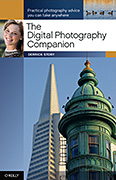Two books that show you how to take better pictures, then process them with ease. Good photography starts with good capture. The Digital Photography Companion gives you creative tips and technical advice for taking top-notch digital photos in a wide range of conditions. In other words, this book will help you make your pictures look better than everyone else's.
Get it Right at Capture
The Digital Photography Companion shows you how to:
- Choose the right camera (DSLRs, compact cameras, or hybrids) and learn all of the typical features they offer, such as face detection, image stabilizers, diopter adjustment, focus assist light, RAM buffer, and more.
-
An A-Z guide of digital camera controls explains everything from Aperture Value (Av) Mode and Autoexposure to White Balance, the Zoom/Magnify Control, and everything in between
-
Advice for a variety of photographic adventures, such as capturing existing light portraits, creating powerful landscape images, and shooting fireworks, underwater portraits, infrared photos, and more, along with lighting and filter tricks.
-
Complete advice for sharing your photos, converting from color to balck & white and more, plus an overview of photo management applications, from Adobe Photoshop Lightroom to Apple iPhoto.
-
Printing doesn't have to be a painful experience. Learn various options, including direct printing without a computer, ordering out, and selecting the right inkjet printer for home (and what to do with it once you get it there.)
-
You also get an appendix with Quick Reference Tables, as well as other useful tables scattered throughout the book.
Take Control of Your Pictures on the Computer
But don't let your creativity end when you click the shutter. Become just as masterful on the computer as you are with the camera. The Photoshop CS4 Companion for Photographers is your complete workflow guide from uploading the images to the computer, to sharing them with the world.
Many photographers, even the pros, feel overwhelmed by all the options that Photoshop provides. Fortunately, The Photoshop CS4 Companion for Photographers spotlights only the critical tools you'll need most often in one compact reference. Professional photographer and bestselling author Derrick Story teaches you how to quickly and efficiently organize and edit your photos without compromising the originals.
The Photoshop CS4 Companion for Photographers lays out an easy to follow workflow that starts with uploading your images to the computer, organizing them, and marking your best shots. From there, you'll see how to quickly:
-
Make basic adjustments such as cropping, color balance, and tonal
adjustments
-
Use advanced tools for black & white conversion, spot removal, batch
processing, and more
- Refine your images using adjustment layers, masking, and smart
objects
-
Learn specific recipes for retouching portraits, swapping colors,
Two Books, One Complete Course in Photography
By having The Digital Photography Companion and The Photoshop CS4 Companion for Photographers at your fingertips, you have a complete course in photography at your disposal.
Post a mini review below, and Derrick Story will send you a signed author plate for each book you own to make them official signed copies.
Post a Mini Review
Let us know what you think about either of these books. Post a mini review right here.


























